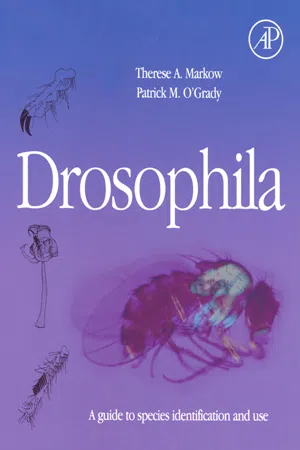
- 272 pages
- English
- ePUB (mobile friendly)
- Available on iOS & Android
About this book
Anyone wishing to tap the research potential of the hundreds of Drosophila species in addition to D.melanogaster will finally have a single comprehensive resource for identifying, rearing and using this diverse group of insects. This is the only group of higher eukaryotes for which the genomes of 12 species have been sequenced.The fruitfly Drosophila melanogaster continues to be one of the greatest sources of information regarding the principles of heredity that apply to all animals, including humans. In reality, however, over a thousand different species of Drosophila exist, each with the potential to make their own unique contributions to the rapidly changing fields of genetics and evolution. This book, by providing basic information on how to identify and breed these other fruitflies, will allow investigators to take advantage, on a large scale, of the valuable qualities of these other Drosophila species and their newly developed genomic resources to address critical scientific questions.* Provides easy to use keys and illustrations to identify different Drosophila species* A guide to the life history differences of hundreds of species* Worldwide distribution maps of hundreds of species* Complete recipes for different Drosophila diets* Offers an analysis on how to account for species differences in designing and conducting experiments* Presents useful ideas of how to collect the many different Drosophila species in the wild
Frequently asked questions
- Essential is ideal for learners and professionals who enjoy exploring a wide range of subjects. Access the Essential Library with 800,000+ trusted titles and best-sellers across business, personal growth, and the humanities. Includes unlimited reading time and Standard Read Aloud voice.
- Complete: Perfect for advanced learners and researchers needing full, unrestricted access. Unlock 1.4M+ books across hundreds of subjects, including academic and specialized titles. The Complete Plan also includes advanced features like Premium Read Aloud and Research Assistant.
Please note we cannot support devices running on iOS 13 and Android 7 or earlier. Learn more about using the app.
Information
Phylogenetic relationships of Drosophilidae
Publisher Summary
The origin of the family Drosophilidae

Table of contents
- Cover image
- Title page
- Table of Contents
- Preface
- Part 1: How to look at flies
- Part 2: How to collect wild flies
- Part 3: How to use living flies
- Part 4: Resources
- Index